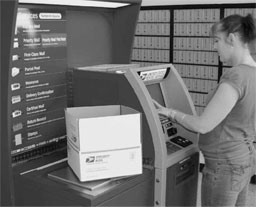Chapter 4 Our Operations

Instead of paying airfare baggage fees, this Delaware college student uses an Automated Postal Center and a Priority Mail Larger Flat Rate Box to ship items home.
POST OFFICES
Local Post Offices offer convenient retail access to mailing and shipping services and provide Post Office Box services to more than 16 million customers. Other services include forwarding mail and acceptance of passport applications. The principal users of retail services are low-volume business mailers and consumers. This year Post Offices and other retail options generated $18.7 billion, 24 percent of total Postal Service revenue. Approximately $4.5 billion of this total was generated through alternate access locations such as Automated Postal Centers (APCs), contract postal units, usps.com, and from the sale of stamps at commercial outlets. These options supplement the Post Office network by expanding the times and places where customers can obtain service.
RETAIL PARTNERS
Contract postal units offer most postal products and services in supermarkets, card stores and other busy retail outlets. These units are staffed by the host retailer, and most feature evening, weekend, and holiday hours of operation. The APC is a self-service kiosk that gives quick, convenient access to the most common transactions. Most of the 2,500 APCs are available 24 hours a day, 7 days a week in Post Offices.
More than $1 billion in stamps are sold on consignment at tens of thousands of commercial venues, including many ATMs, drug stores, supermarkets, and convenience stores. Stamps by Mail is a service that allows customers to order stamps, postal cards, and stamped envelopes and have them delivered by mail. Stamps by Mail processed 4.2 million orders this year.
Usps.com
In September, the Postal Service launched a redesigned usps.com aimed at improving customer satisfaction. The new homepage features easier-to-find links to popular products and services, with enhanced graphics that help customers better navigate the site. In 2008, the site received 433 million visits, a 12 percent increase. Before the redesign, the Brookings Institution ranked the site fourth among 61 government agency Web sites, based on effectiveness at using interactive features to engage the public and provide services. In addition, usps.com was included in BtoB Magazine’s list for “The 10 Best Internets for BtoB Customers.”
Since 2002, when the Postal Service introduced Click-N-Ship online shipping, there has been continuous growth in the number of users and revenue. Click-N-Ship transactions increased dramatically over 2007. Online customers can use stored addresses to create labels with postage, and then click on a link to schedule a package pickup, saving time and a trip to the Post Office. International mailing was made easier for customers by combining all international products into the Click-N-Ship application. Other Click-N-Ship enhancements include an option to print two-up labels, a large Priority Mail Flat Rate box option, an option for Express Mail Sunday/Holiday delivery, and Express Mail hold for pickup service.
The Postal Store on usps.com is the primary online resource for customers to obtain mailing services and shipping supplies. Revenue from the Postal Store experienced a 10 percent increase. The site is responsible for almost 70 percent of shipments from the Stamp Fulfillment Services Center in Kansas City, and for two-thirds of expedited shipping supplies fulfillment. The Postal Store also offers a wide variety of stamps and stamp products.
Customers can now locate and pay for Post Office boxes  online. Customers can make a one-time payment or set up automatic payments, which will reduce late payments and unintended box closures.
online. Customers can make a one-time payment or set up automatic payments, which will reduce late payments and unintended box closures.
Also created this year were a new eco-friendly Green “micro site”, an easy-to-use consolidated site for the pricing of postal products and services, redesigned sites for Direct Mail and frequently asked questions (FAQs), a site that simplifies parcel returns, and a site for Vision 2013, the five-year strategic plan for 2009-2013 that offers a broad perspective of what it will take for the Postal Service to succeed in the future.